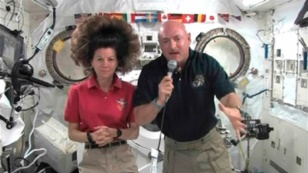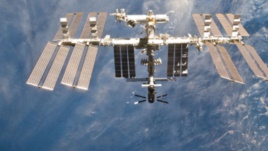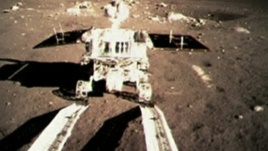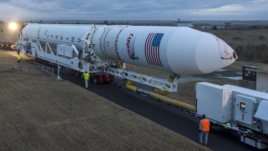VOA慢速英語:在太空中呆的時(shí)間過長會影響你的身體機(jī)能和意識
From VOA Learning English, this is Science in theNews.
I’m Anna Matteo.
And I’m Christopher Cruise.
 |
Today we report on recent developments in spacescience. We tell about the growing demand forcommunications satellites and space-based imagingservices. We also tell about China’s first robotic vehicleon the moon. But first, we examine the effect of longerspace flights on humans.
How Do Long Periods in Space Affect the Bodyand Mind?
Human beings have a natural desire to explore the unknown. People with astrong interest in space like to say it is the last place left to explore. Butscientists are warning that space exploration for long periods is not going to be easy. They say the human body is not designed to stay in space over anextended period.
The New York Times recently published a report about scientists who arepreparing astronauts for a trip to the Moon. The newspaper said the scientistswant to make sure that their crews return home in good health. But there aremany problems to be solved before people are ready for long trips to theMoon, an asteroid or even the planet Mars.
Humans developed on a planet with a surface that ismore than 70 percent water. Our bodies are also about70 percent water. When there is no gravity that watermoves up toward the head, raising pressure in theskull. Arms and legs grow weaker at what is called zerogravity because they no longer need to push against theforce of gravity.
 |
|
The International Space Station |
Five years ago, astronauts who spent weeks in spacereported a change in their eyesight. These astronautswere members of the crew on the International Space Station. Researchshowed a change in the shape of their eyes. Normally-round eyeballs hadbecome flat during time in space. The research also showed that the right eyewas affected more than the left, and that men were more affected thanwomen. Scientists could not find an explanation for the differences.
Bone loss was one of the problems first reported by astronauts returning toEarth after longer stays in space. So scientists designed exercise machinesto use on the space station. Tests showed that the exercise equipment helpedspace travelers keep their bones almost as strong as when they left Earth.
There are other health issues for astronauts who spend a long time in space.They may have problems eating and sleeping. But the biggest health issue isexposure to radiation. On Earth, human beings are protected by theatmosphere and the planet’s magnetic field. In outer space, there is no suchprotection.
For more than 50 years, the health of American astronauts has been aconcern of NASA -- the National Aeronautics and Space Administration. NASAdoes not let the risk of cancer for its astronauts rise more than three percentduring their lifetime. But there is more to be worried about than a possibleincreased risk of cancer.
On Long Island, New York, scientists have been studying the effect of cosmicrays on mice. The scientists say they have found possible brain damage to the animals.
Another problem for astronauts is the difficulty of exchanging information withpeople on Earth during long flights. There is no delay now in communicatingbetween astronauts and flight headquarters -- known as Mission Control. Butmessages between Earth and distant planets will take minutes to arrive.
Mental health is another important issue for long space flights. And, becauseastronauts will be inside their small spaceship together for months, they mustwork well as a team. There could be problems if one of the astronautsdevelops personality issues.
NASA plans to send humans to Mars by 2030. Themission would take about two-and-a-half years. That isalmost six times longer than the longest stay in space.One reason NASA extended the life of the InternationalSpace Station was to do more medical research on theeffects of a longer stay in space.
 |
| Mars |
Starting in 2015, an American astronaut and a Russiancosmonaut are to stay on the space station for one fullyear. The Russian cosmonaut Valery Polyakov hasalready stayed longer than a year in space. He worked on the Russian spacestation Mir in 1994 and 1995.
Scientists say they now have better measuring devices and testing methods.They want to use them to study the changes in the body and mind during longstays in zero gravity. Their research is aimed at learning if such changes inphysical condition will remain or will return to normal a few months after theyhave returned to Earth.
China’s “Jade Rabbit” Explorer: Sleeping on the Moon
Robots in space do not have the health problems of humans, but they candevelop operating problems. China’s first Moon explorer landed on the Moon inDecember. But it developed problems in January.
 |
|
China's first moon rover, "Jade Rabbit," touches the Moon's surface and leaves deep marks. |
The Chinese news agency Xinhua reported thatscientists were working to fix the robotic vehicle, whichis known as “Jade Rabbit.” The vehicle is named for asmall animal in traditional Chinese stories about amoon goddess.
China’s State Administration of Science, Technologyand Industry for National Defense said the problemswere a result of what it called “complicated lunarsurface environment.” The agency provided no otherinformation.
But in February, the Jade Rabbit showed signs of life. A spokesman for theprogram was reported as saying technicians are still investigating the causeof what he called the “mechanical control malfunction.” The problem causedthe vehicle to go into a rest or sleep mode. The Jade Rabbit is designed toenter sleep mode to survive the extreme cold nights on the moon.
The rover came to life briefly on February 23rd before entering sleep modeagain. There have been no reports of the Jade Rabbit waking since then. Thedevice remains in its third sleep since landing on the Moon.
Future for Businesses Working in Space Looks Hopeful
Launching rockets into space has become almost commonplace. Thedemand for communications satellites and space-based image services isgrowing.
Today, space efforts are a $200 billion a year industry. Joint efforts betweengovernments and businesses are helping to lower costs and increase ourunderstanding of the universe.
The business of space looks good for Orbital Sciences Corporation, acompany based in the United States. In January, the company launched itsAntares rocket. The rocket was carrying the first of eight planned supplyshipments to the International Space Station.
 |
|
The Orbital Sciences Antares rocket, used to launch a spacecraft to resupply the International Space Station (AP Photo/Bill Ingalls) |
Orbital Sciences is one of two American companiespaid by NASA to transport supplies to the space station.
A company called “Arianespace” is a private Europeanspace business. Arianespace launched its first satellite30 years ago. It says 2014 may be its busiest year yet.
Clayton Mowry heads the American division of thecompany. He says the increase in rocket launches ispartly the result of increased demand for space-basedtechnologies. These include extreme high-definitionbroadcasts and satellite broadband service.
While there is more demand for satellites, the end of NASA’s space shuttleprogram in 2011 has hurt the space industry.
Janice Starzyk works at International Launch Services. She works oneducation issues at the Washington Space Business Roundtable.
“The shuttle program shutting down was a huge, huge set of layoffs in theindustry.”
But even as NASA reduces its spending, other countries have announcedplans to explore space. In December, China became just the third country toland a space vehicle on the Moon. A month later, India launched its firstcommunications satellite.
Trying to Prove Space Flight Doesn’t Have to Be Costly
In Denmark, two people are attempting to prove that space flight does notneed to be costly. They are using designs that are free to anyone. They areattempting to pay for rocket launches by asking interested people to make adonation to the project.
Kristian Von Bengtson helped start the company, called CopenhagenSuborbitals. He has dreamed since he was a boy of launching a rocket 100kilometers into space. He wants to launch a rocket built by a private companyfor less money than expected.
“Everybody believes that space flight -- manned space flight -- can only bedone with billions of dollars, and it has to be government-financed. I hope that we can show that you can do it on a shoestring budget. You can pretty muchdo it yourself.”
Kristian Von Bengtson hopes to launch a rocket carrying astronauts intospace by 2020.
Students: Think About Space Careers
As more companies enter the space industry, they will need highly-trained andeducated workers. Janice Starzyk says the Space Business Roundtable willcontinue to urge students to consider careers in space.
"Actually, it’s a major problem in, in most countries of getting young peopleinterested in, in studying engineering, and specifically aerospace engineering.”
She says attendance at her organization’s space academy program has risenover the last three years. She says that as demand increases for rocketlaunches, so will the demand for highly-trained engineers and other spaceworkers.
This Science in the News was written and produced by Christopher Cruise.
I’m Anna Matteo.
And I’m Christopher Cruise.
You can comment on this story on our website, learningenglish.voanews.com.Join us again next week for more news about science on the Voice ofAmerica.
- 用戶搜索
瘋狂英語 英語語法 新概念英語 走遍美國 四級聽力 英語音標(biāo) 英語入門 發(fā)音 美語 四級 新東方 七年級 賴世雄 zero是什么意思伊犁哈薩克自治州世紀(jì)嘉苑二期英語學(xué)習(xí)交流群
- 頻道推薦
- |
- 全站推薦
- 推薦下載
- 網(wǎng)站推薦




















